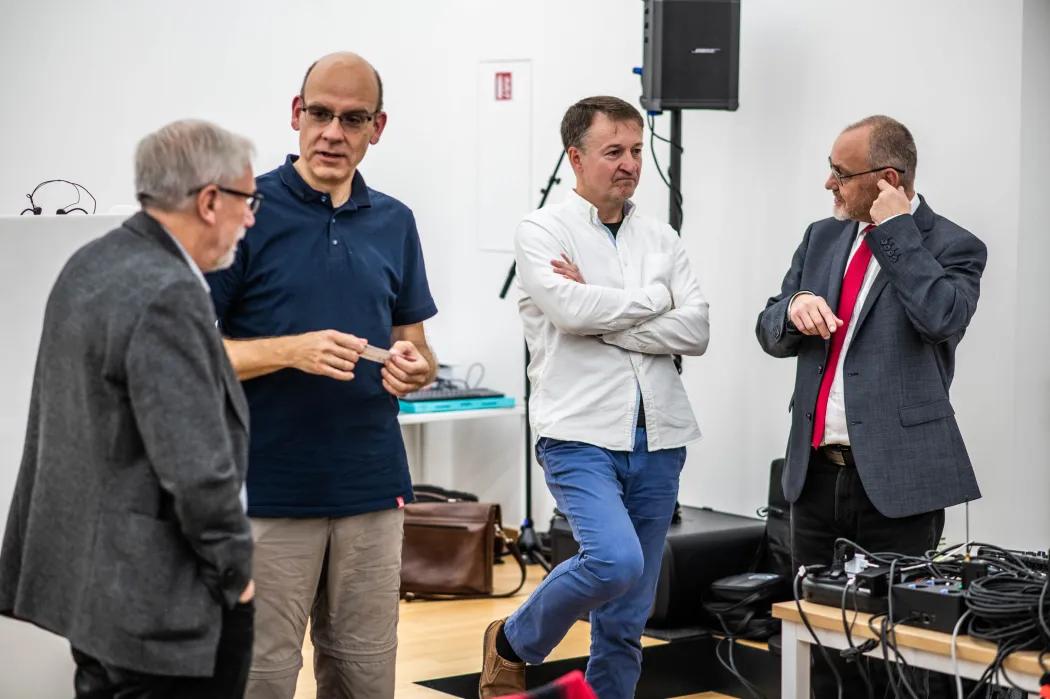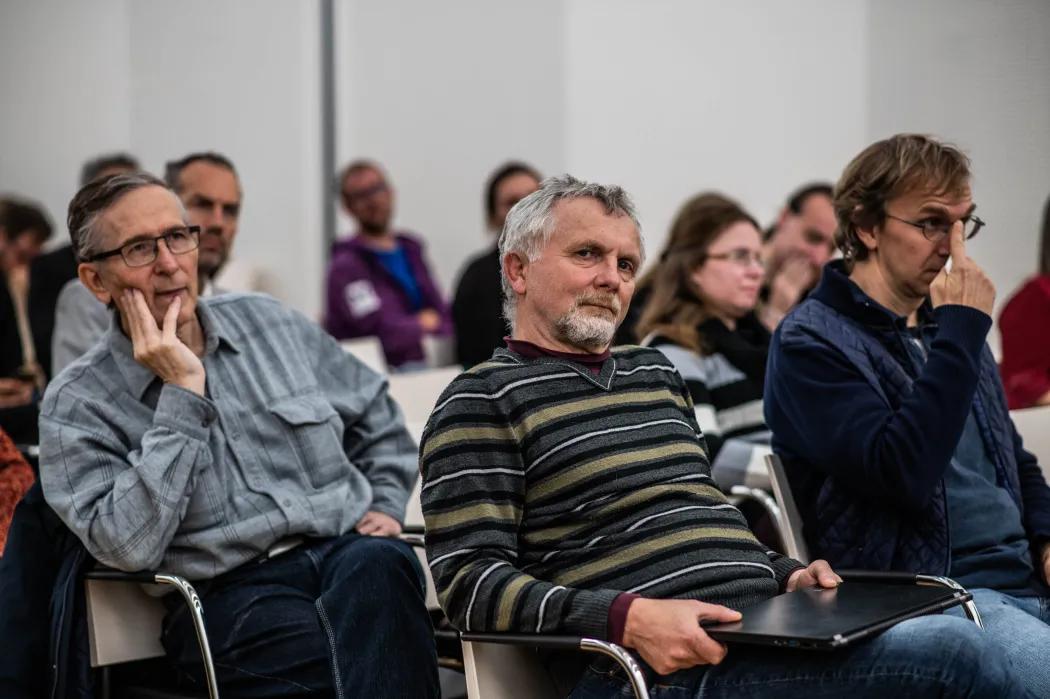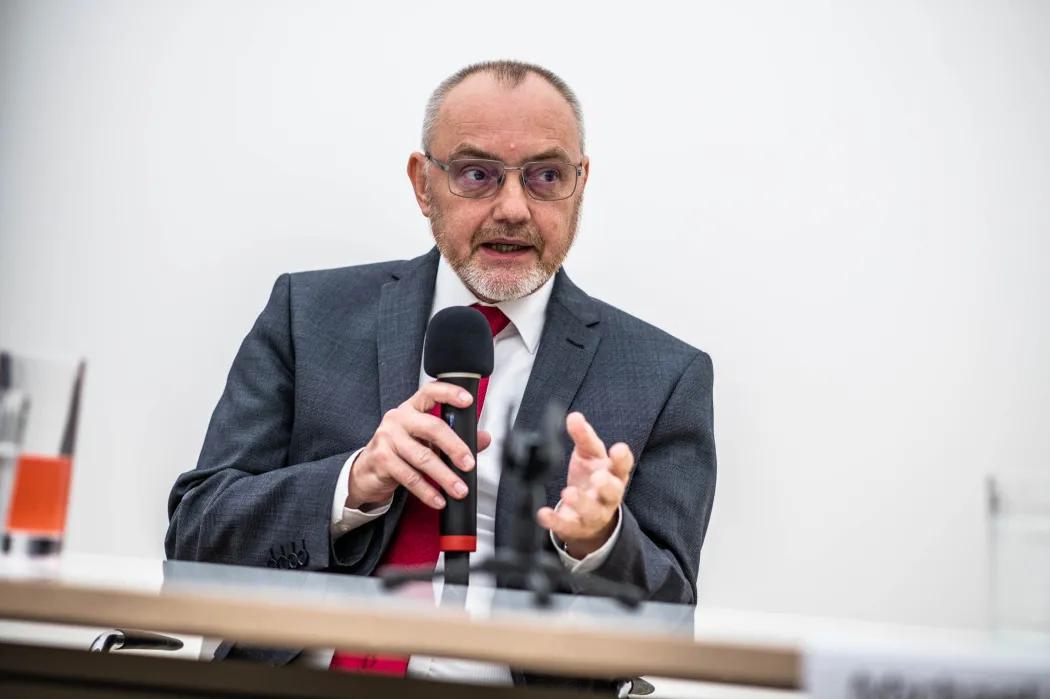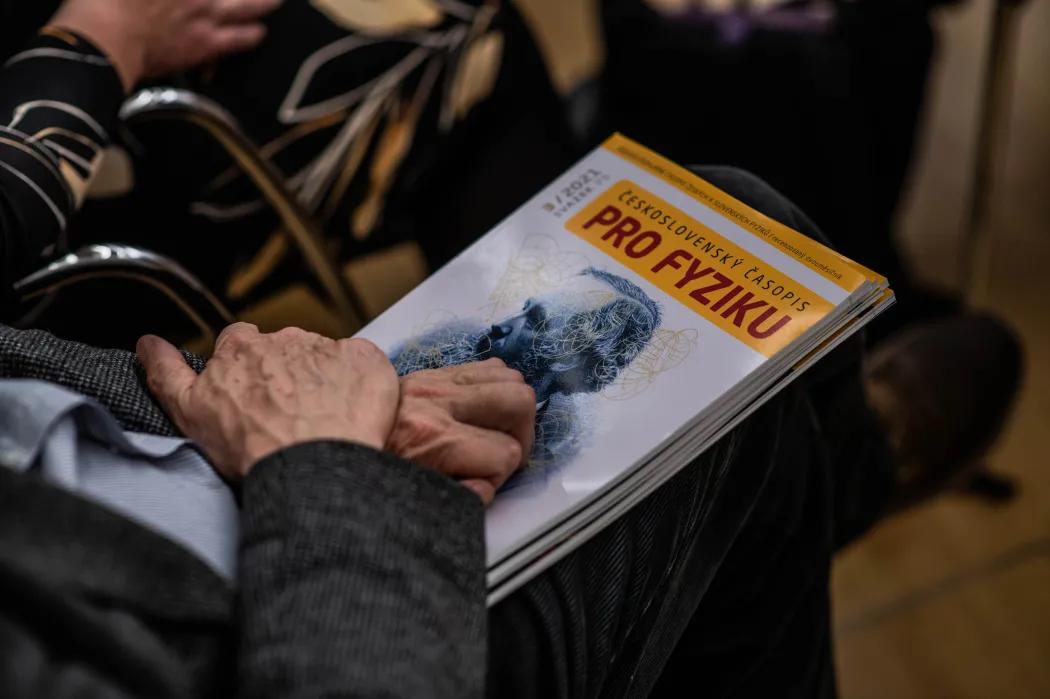Does it make sense to publish a printed journal that deals with the promotion of physics? With this controversial question, the director of the Institute of Physics, Michael Prouza, opened a discussion on the future of the popularization of physics. The debate took place on Monday, October 24, on the occasion of the 150th anniversary of the Československý časopis pro fyziku journal in a crowded hall of the SOLID21 building, and was followed by expert lectures on the history of physics and its popularization.
The five popularizers of physics who accepted participation in the panel debate – the editor-in-chief of the Československý časopis pro fyziku journal, Professor Jan Valenta, his predecessor Doctor Libor Juha, Associate Professor Jiří Dolejší from the Czech Physical Society, Professor Jiří Podolský from the Faculty of Mathematics and Physics of Charles University and Professor Jiří Chýla from the Institute of Physics – unanimously supported the continued existence of the printed periodical in response to the initial challenging question.
The reasons for supporting a printed medium in the digital age, apart from a shared fondness for scrolling through a paper version and references to the uncomfortable way of reading in an electronic form, were diverging. While the current editor regards the journal as a cultural element and the highest degree of popularisation on the verge of science, his predecessor highlighted the contribution to the consolidation of Czech physical terminology. This otherwise occurs only in textbooks, which, however, are not uniformly editorially processed and are not published in some fields.
"Scrolling through the yellow journal is pleasing and brings knowledge," said Jiří Dolejší as one of the arguments for maintaining the periodical. His colleague from the Faculty of Mathematics and Physics of Charles University, Jiří Podolský, also pointed out the overlap of the journal into natural science and philosophy. "If the physics community is to present itself well, it needs a prestigious journal. But publishing something so amazing every two months must be challenging and it may therefore be necessary to increase the intervals between individual issues," he said, while dismissing concerns about the future of printed media by referring to the outcome of a similar debate in the 1990s, when the end of printed media was also discussed in connection with the then fashionable multimedia on CD.
The journal attracts more and more readers
The magazine currently has a constant number of sold copies and thanks to the possibility of accessing the electronic version after simple registration, the number of readers keeps growing. This is also why the Institute of Physics decided to support the creation of a new website for the magazine. "Younger groups of readers are becoming more and more difficult to reach as new forms of popularization are emerging, especially using social media. They are different, abbreviated, and it is therefore a question whether a magazine is not a dinosaur that survived, but I hope it is not the case," Professor Valenta commented on the composition of the reader community.
"We do not target high school students, but their teachers and possibly university students," Professor Valenta explained the content orientation of the magazine. The choice of the target group is closely related to the pressure on scientists to publish the majority of professional articles in international peer-reviewed journals in English, which is one of the reasons why the current editors have difficulty finding contributions. "The inflow of spontaneous contributions is very small, so most articles are heavily requested texts, some fields are not represented yet," explained the editor-in-chief, and added: "It is increasingly difficult to fill the news and articles, the pedagogical part is easier, therefore the journal is leading in that direction. It is not what I want."
The difficult work of editors in obtaining contributions was confirmed also by the previous editor-in-chief Libor Juha: "We tried to approach supervisors of the theses and dissertations so that in case of excellent theses, which have a well-prepared theoretical part, the authors would elaborate them into an article for the journal. However, we were not very successful, because after completing and defending a thesis, both the motivation and the possibilities to process the manuscript quickly are quickly lost both in students and supervisors."
As one of the conditions for the increase in the number of articles submitted, Professor Podolský identified a necessary change in the overall climate of science evaluation. Alice Valkárová, a member of the Board of the Czech Science Foundation, pointed out the positive development in this context: "Science evaluation is a difficult issue, but I would like to point out that there is a new initiative in the world for evaluating scientists, where mechanical h-indices are abandoned and evaluations that do not fit into numerical parameters are added, such as popularization and numbers of students led.”
Recommendations for the following 150 years of existence
The panelists tried to formulate options for the development of the journal, and Libor Juha would consider the introduction of a form of mini-reviews, i.e. a brief overview of the chosen topic, as one of the possible forms of revival of the periodical. These are also being promoted in the world because the expansion of bibliographic databases (WOS and others) reduces the importance of large articles with hundreds of citations. Professor Chýla recommended complementing the current content with news and comments by experts in the given field, which would give the journal the opportunity to respond to current events. He would also welcome a section of polemics, which would not need to be regular but would reflect discussions held in the physics community, which are currently not included in the journal.
Are social media the only means that can reach young people?
The second half of the debate was devoted to other ways of popularizing physics and activities that will play the most important role in the future and will have the greatest impact on young people. "In my time as director, there have not been many really active popularizers at the Institute of Physics, now and then some appear, but not many. They seem to be the ones who have an internal inclination to do this and see it as an essential part of their work. They do not only write professional articles, but also like to explain to people what they are doing in a simple and understandable way. We can try to support them a little more, but even not an inconsiderable financial support for popularization activities will not work for all of them," Michael Prouza shared his experience from the Institute of Physics.
The long-term support for astronomy and solids was at the turn of the millennium followed by particle physics, which made it to the media also thanks to the cooperation of Czech scientists with CERN. "At our workplaces, young people already consider it normal to popularize, whether they make a film, write an article or take part in a festival. It is important that popularization be considered a normal part of scientific work," said Jiří Dolejší.
Where to look for enthusiastic young physicists
"We can continue in visiting observatories, libraries, elementary and secondary schools, where there are twenty, thirty students in a class, and communicate what we consider interesting and important. In this way, we might also reach those who will never be involved in physics. But it may influence what the majority of society thinks about science and physics in the future," said Professor Podolský. In his opinion, enthusiastic young physicists born in the Czech Republic can be addressed in any way that directs them to a physics-oriented university. But they would probably enrol in it even without our effort. However, the discussion also showed that the formative period of the first serious interest in science is around the age of 11-12 years. The physics community should therefore not renounce the popularization effect on elementary school pupils and especially their teachers.
Both Professor Podolský and Libor Juha placed great emphasis on the presentation of the positive influence of scientific knowledge and education. According to Juha, this is what is missing: "In order for popularization to be effective, at least part of the physics community have to engage in a relatively vigorous struggle with the political class. It is beginning to look like formal education is almost an obstacle."
As clearly successful longer-term popularization projects, the participants identified correspondence seminars, physics Thursdays at the Czech Technical University and the Faculty of Mathematics and Physics, and a show of popularization activities in physics, which has been organized by the Czech Physical Society every two years since 2007.














